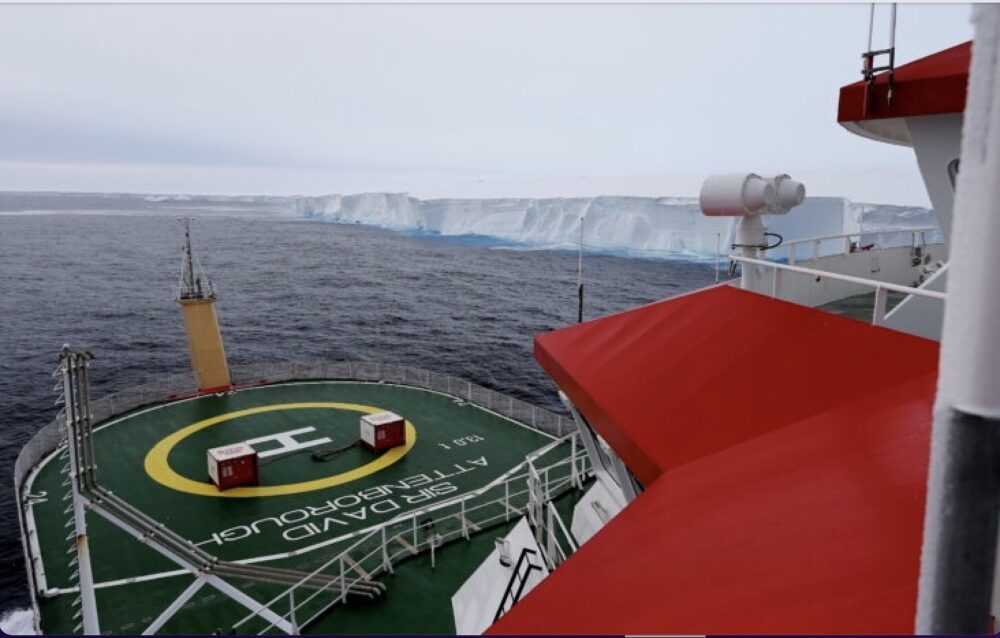The largest iceberg in the world, A23a, is advancing towards the South Georgia islands, in the southern Atlantic Ocean, east of the Falkland islands, putting at risk the extraordinary biodiversity of the region, including the survival of millions of penguins, seals and marine species Unique to the world
The Iceberg A23a, a floating threat
A23A, with a surface higher than double that of London, represents one of the most impressive and fascinating natural structures ever observed. This huge floating mass has detached itself in 1986 by the Filchner-Ronne glacial platform in Antarctica, and spent more than three decades trapped in the seabed of the Weddell sea, where its stable position slowed the dissolution process.
Only in 2020 he started his long journey to the southern ocean, but was temporarily hindered by an ocean phenomenon known as Taylor columna vortex caused by submarine mountains that create circular currents. At the end of 2023, however, Iceberg resumed his movement towards the South Georgia islands, a archipelago located in the southern Atlantic Ocean at about 1,390 kilometers east of the Falkland islands.
South Georgia, a strategic point for marine ecology
This group of lands is located in a strategic position, between the cold waters of the Antarctic Polar Circle and the most temperate currents of the southern Atlantic. Their geographical position is of fundamental importance for global marine ecology, since the surrounding waters are rich in nutrients that feed an extraordinarily varied ecosystem.
Often compared to the Galapagos for the exceptional biological variety, these austral lands host one of the largest concentrations of marine biodiversity in the world. The colonies of royal penguins, macaroni (crest penguins with yellow tufts) and gentoo (penguins with orange beak and black head), are among the most numerous on the planet.
Even the seals and marine elephants find refuge along their beaches. In addition, the surrounding waters are teeming with Krill Antarctic, a tiny fundamental creature for the entire food chain of the region. This crustacean is the main source of food for whales, penguins, seals and many other marine species.
The ecological wealth of this archipelago is not limited to marine fauna. Albatros and other species of marine birds nest on the steep cliffs and the heights of these islands. Thanks to their distance from the main inhabited centers, the territory has remained largely uncontaminated by human activity, even if the climate change and extreme events such as the arrival of the iceberg A23a threaten to alter this balance.
Threat to marine habitats
With an estimated mass of over 1,700 square kilometers, the Iceberg A23a represents a serious threat to marine ecosystems. The collision with low waters and underwater platforms could block access to the main power areas of many animal species.
Penguins and seals, which depend on short paths to get the Krill, risk being forced to follow greater distances. Which could compromise their survival. In addition, the release of large quantities of fresh water during the melting of the iceberg could alter the salinity of the surrounding waters, influencing the availability of essential nutrients and local food chains.
These changes may have global repercussions, given the interconnection between the oceanic systems of the planet. A past example demonstrates the gravity of these phenomena: in 2004, the Iceberg A38-B blocked the feeding routes of penguins and seals, causing a drastic drop in animal populations. A23a, being significantly larger, could cause even more extensive damage.
Impacts on marine biodiversity
The dissolution of the iceberg releases enormous quantities of fresh and nutritious water, such as iron, in the surrounding ocean. This phenomenon can have both positive and negative impacts on marine biodiversity. On the one hand, the iron release could stimulate the growth of phytoplankton, which is the base of the Marina food chain. A greater presence of phytoplankton can encourage the productivity of ecosystems, attracting Zooplankton, fish, marine birds and even marine mammals.
However, such a drastic change in the composition of the waters could encourage some species to the detriment of others, altering ecological balances. According to the biologist of British Antarctic Survey (The British organization responsible for scientific research and dissemination on Antarctica) Laura Taylor, Iceberg’s merger of this dimensions can create temporary ecosystems, but the long -term effects remain uncertain and could destabilize the entire marine habitat.
Climatic reflections
A23A’s journey represents a symbol of the ongoing climate change. The increase in global temperatures has accelerated the detachment and merger of Antarctic Iceberg, contributing to the rise in sea level and the alteration of the natural cycles of the oceans. British Antarctic Survey scientists on board the Sir Shooting Sir David Attemptoughare carefully monitoring the evolution of the iceberg to understand how similar events can influence the seizure of carbon and the cycles of global nutrients. These data are essential to develop more effective mitigation strategies against the consequences of climate change.
Source
Science Alert

